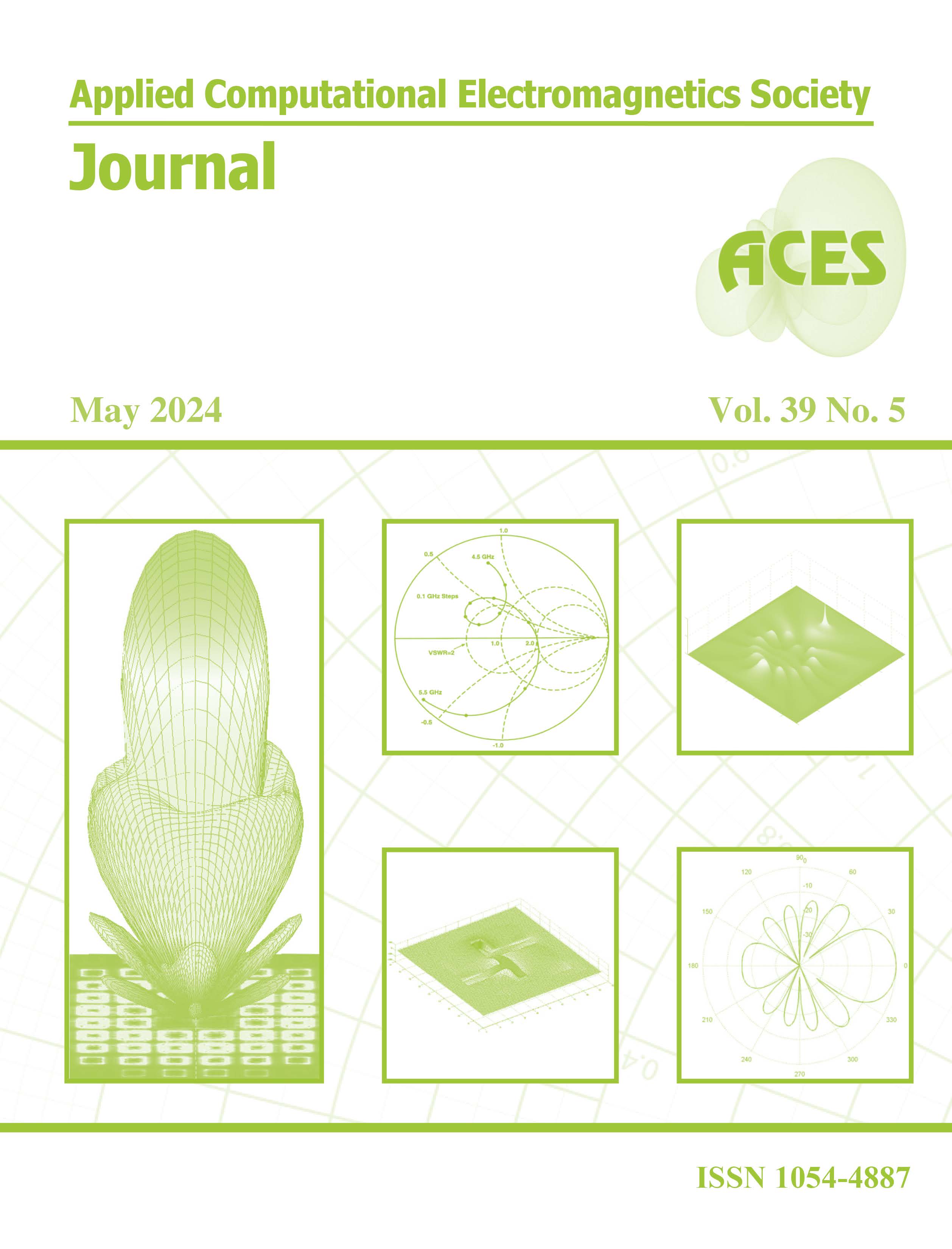Efficient MAPoD via Least Angle Regression based Polynomial Chaos Expansion Metamodel for Eddy Current NDT
DOI:
https://doi.org/10.13052/2024.ACES.J.390510Keywords:
Boundary element analysis, eddy current nondestructive testing (NDT), meta learning, model-assisted probability of detection (MAPoD), polynomial chaos expansions with least angle regression (LAR-PCE)Abstract
In this article, a metamodeling approach based on non-intrusive polynomial chaos expansion (PCE) with least angle regression (LAR) method is used in boundary element analysis for a model-assisted probability of detection (MAPoD) study of eddy current nondestructive testing (NDT) systems. The LAR-PCE metamodel represents the NDT system model responses by a set of coefficients with the polynomial basis functions in lieu of pure kernel degeneration accelerated boundary element method (KD-BEM) based physical model. Both the computational accuracy and efficiency of the LAR-PCE metamodel over the ordinary least squares (OLS) based PCE metamodel are demonstrated by testing the 3D eddy current NDT benchmarks with different system setups, flaw lengths and widths. The simulation results show two digits accuracy of the PoD metrics compared with the ones achieved by the KD-BEM based physical model as the benchmark. The LAR-PCE metamodel has remarkable improvements in computational efficiency over the OLS-PCE metamodel and accelerates the MAPoD study.
Downloads
References
A. Sophian, G. Tian, D. Taylor, and J. Rudlin, “Electromagnetic and eddy current NDT: A review,” Insight, vol. 43, no. 5, pp. 302-306, 2001.
J. Schijve, Fatigue of Structures and Materials. Dordrecht: Springer, 2009.
M. R. Bato, A. Hor, A. Rautureau, and C. Bes, “Experimental and numerical methodology to obtain the probability of detection in eddy current NDT method,” NDT&E International, vol. 114, pp. 1-13, 2020.
A. Moskovchenko, M. Švantner, V. Vavilov, and A. Chulkov, “Analyzing probability of detection as a function of defect size and depth in pulsed IR thermography,” NDT&E International, vol. 130, pp. 1-9, 2022.
N. Yusa, H. Song, D. Iwata, T. Uchimoto, T. Takagi, and M. Moroi, “Probabilistic analysis of electromagnetic acoustic resonance signals for the detection of pipe wall thinning,” Nondestructive Testing and Evaluation, vol. 36, pp. 1-16, 2021.
K. Tschöke, I. Mueller, V. Memmolo, M. Moix, J. Moll, Y. Lugovtsova, M. Golub, R. Sridaran, and L. Schubert, “Feasibility of model-assisted probability of detection principles for structural health monitoring systems based on guided waves for fiber-reinforced composites,” IEEE Transactions on Ultrasonics, Ferroelectrics, and Frequency Control, vol. 68, no. 10, pp. 3156-3173,2021.
A. Rosell, “Efficient finite element modelling of eddy current probability of detection with transmitter–receiver sensors,” NDT&E International, vol. 75, pp. 48-56, 2015.
P. Baskaran, D. J. Pasadas, A. Ribeiro, and H. Ramos, “Probability of detection modelling in eddy current NDE of flaws integrating multiple correlated variables,” NDT&E International, vol. 123, pp. 1-8, 2021.
R. Miorelli, C. Reboud, T. Theodoulidis, J. Martinos, N. Poulakis, and D. Lesselier, “Coupled approach VIM–BEM for efficient modeling of ECT signal due to narrow cracks and volumetric flaws in planar layered media,” NDT&E International, vol. 62, pp. 178-183, 2014.
K. Pipis, A. Skarlatos, T. Theodoulidis, and D. Lesselier, “ECT-signal calculation of cracks near fastener holes using an integral equation formalism with dedicated Green’s kernel,” IEEE Transactions on Magnetics, vol. 52. no. 4, pp. 1-8, 2015.
J. Song, C. C. Lu, and W. C. Chew, “Multilevel fast multipole algorithm for electromagnetic scattering by large complex objects,” IEEE Transactions on Antennas and Propagation, vol. 45, no. 10, pp. 1488-1493, 1997.
Y. Bao, Z. Liu, J. Bowler, and J. Song, “Multilevel adaptive cross approximation for efficient modeling of 3D arbitrary shaped eddy current NDE problems,” NDT&E International, vol. 104, pp. 1-9, 2019.
W. Chai and D. Jiao, “An ?2
-matrix-based integral-equation solver of reduced complexity and controlled accuracy for solving electrodynamic problems,” IEEE Transactions on Antennas and Propagation, vol. 51, no. 10, pp. 3147-3159,2009.
Y. Bao, T. Wan, Z. Liu, J. Bowler, and J. Song, “Integral equation fast solver with truncated and degenerated kernel for computing flaw signals in eddy current non-destructive testing,” NDT&E International, vol. 124, pp. 1-13, 2021.
S. Bilicz, “Sparse grid surrogate models for electromagnetic problems with many parameters,” IEEE Transactions on Magnetics, vol. 52, no. 3, pp. 1-4, 2015.
L. Gratiet, B. Iooss, G. Blatman, T. Browne, S. Cordeiro, and B. Goursaud, “Model assisted probability of detection curves: New statistical tools and progressive methodology,” Journal of Nondestructive Evaluation, vol. 36, no. 1, pp. 1-12,2017.
G. Blatman and B. Sudret, “Adaptive sparse polynomial chaos expansion based on least angle regression,” Journal of Computational Physics, vol. 230, no. 6, pp. 2345-2367, 2011.
X. Du and L. Leifsson, “Efficient uncertainty propagation for MAPOD via polynomial chaos-based Kriging,” Engineering Computations, vol. 37, no. 1, pp. 73-92, 2020.
Y. Bao, “Modeling of eddy current NDT simulations by Kriging surrogate model,” Research in Nondestructive Evaluation, vol. 34, pp. 1-15, Sep. 2023.
Y. Bao, Z. Liu, J. Bowler, and J. Song, “Nested kernel degeneration-based boundary element method solver for rapid computation of eddy current signals,” NDT&E International, vol. 128, pp. 1-9, 2022.
S. M. Stigler, “The epic story of maximum likelihood,” Statistical Science, vol. 22, pp. 592-620, 2007.
S. K. Burke, “A benchmark problem for computation of Δ
Z in eddy-current nondestructive evaluation (NDE),” Journal of Nondestructive Evaluation, vol. 7, pp. 35-41, 1988.




